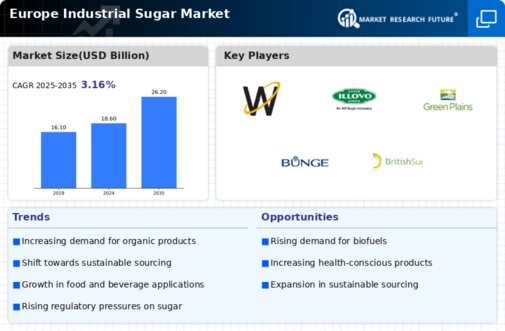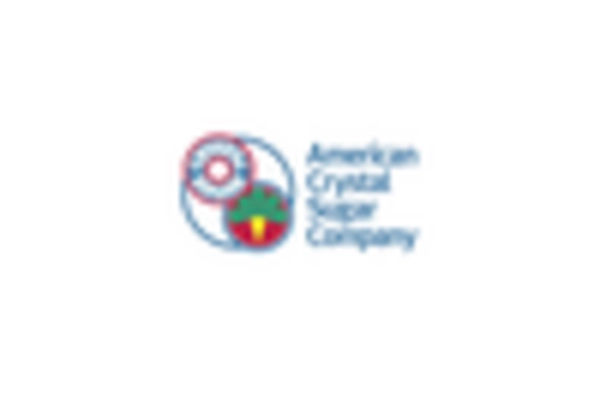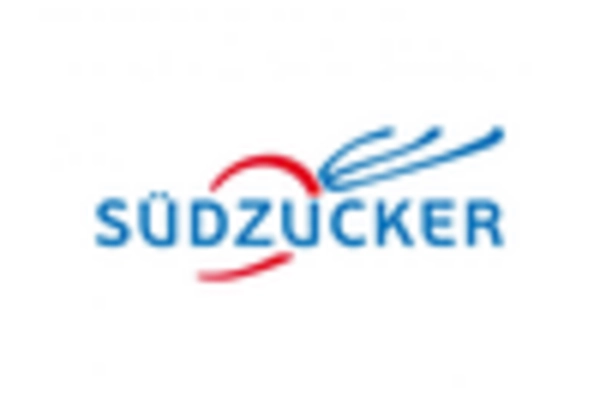Innovations in Sugar Substitutes
The industrial sugar market in Europe is witnessing a surge in innovations related to sugar substitutes, driven by changing consumer preferences and health trends. The introduction of natural sweeteners, such as stevia and monk fruit, is gaining traction as consumers seek healthier alternatives. This shift is likely to impact the demand for traditional sugar, as manufacturers explore ways to reformulate products to reduce sugar content. According to industry reports, the market for sugar substitutes is expected to grow by approximately 6% annually through 2030. This trend may compel traditional sugar producers to adapt their offerings, thereby influencing the overall dynamics of the industrial sugar market in Europe.
Rising Demand for Processed Foods
The industrial sugar market in Europe experiences a notable increase in demand for processed foods, which significantly drives sugar consumption. As consumer preferences shift towards convenience, the processed food sector is projected to grow at a CAGR of approximately 4.5% from 2025 to 2030. This trend is likely to bolster the industrial sugar market, as sugar serves as a key ingredient in various products, including baked goods, sauces, and beverages. Furthermore, the growing trend of ready-to-eat meals and snacks is expected to further enhance the demand for industrial sugar. Consequently, manufacturers are likely to increase production capacities to meet this rising demand, thereby impacting the overall dynamics of the industrial sugar market in Europe.
Economic Growth and Consumer Spending
The industrial sugar market in Europe is closely tied to economic growth and consumer spending patterns. As economies recover and consumer confidence improves, there is a corresponding increase in disposable income, which tends to boost demand for sweetened products. In 2025, the European economy is projected to grow by around 2.5%, which could lead to higher consumption of sugar in various sectors, including confectionery and beverages. This economic upturn may encourage manufacturers to invest in expanding their production capabilities to cater to the anticipated rise in demand. Thus, the interplay between economic conditions and consumer behavior is likely to play a crucial role in shaping the industrial sugar market in Europe.
Regulatory Framework and Trade Policies
The industrial sugar market in Europe is significantly influenced by the regulatory framework and trade policies established by the European Union. Recent reforms in agricultural policies, including the Common Agricultural Policy (CAP), have implications for sugar production quotas and pricing mechanisms. For instance, the EU's commitment to reducing sugar production has led to a decrease in domestic supply, which may create upward pressure on prices. Additionally, trade agreements with non-EU countries could alter import tariffs, affecting the competitive landscape of the industrial sugar market. As a result, stakeholders must navigate these regulatory changes to optimize their market strategies and ensure compliance, which could ultimately shape the future of the industrial sugar market in Europe.
Environmental Concerns and Sustainable Practices
Environmental concerns and the push for sustainable practices increasingly affect the industrial sugar market in Europe. As consumers become more environmentally conscious, there is a growing demand for sustainably sourced sugar. This trend is prompting manufacturers to adopt eco-friendly practices, such as reducing carbon footprints and implementing responsible sourcing strategies. Reports indicate that approximately 30% of consumers in Europe are willing to pay a premium for sustainably produced products. Consequently, companies in the industrial sugar market may need to invest in sustainable production methods to meet consumer expectations and regulatory requirements, thereby influencing the overall market landscape.


















Leave a Comment